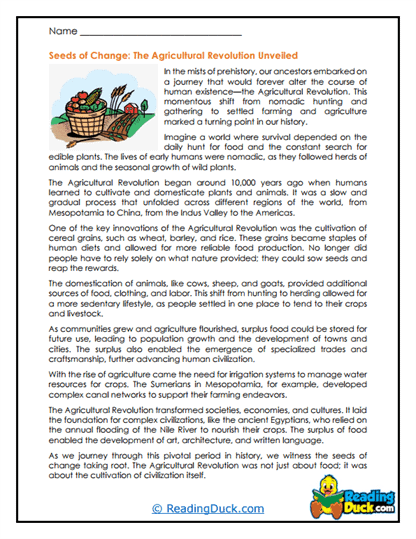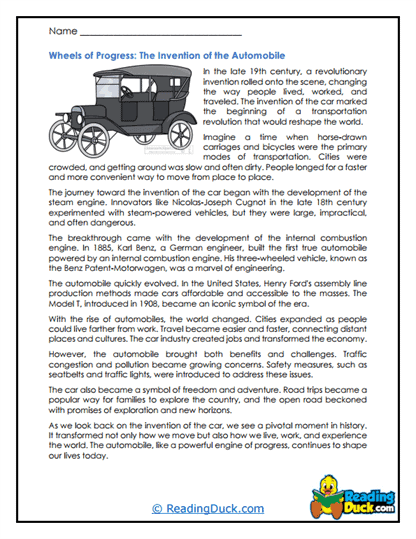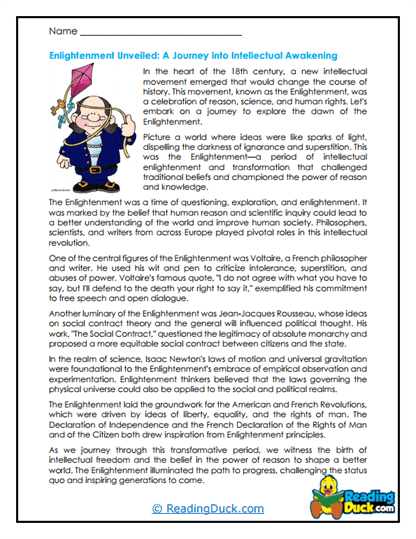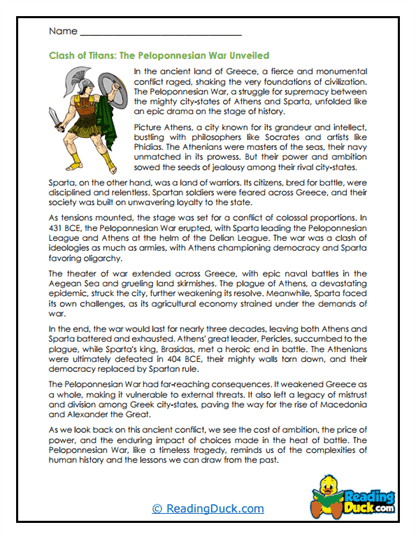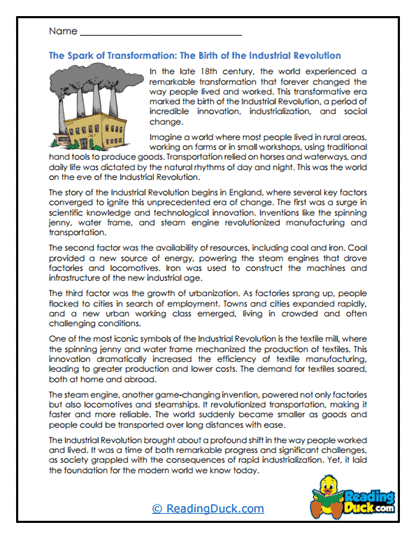Descriptive Nonfiction Worksheets
About Our Descriptive Nonfiction Worksheets
Our Descriptive Nonfiction Worksheets collection offers a dynamic resource for educators and students to explore the world of nonfiction through rich, detailed texts. Each worksheet set contains reading passages that bring real-world experiences, places, or objects to life using vivid descriptions and sensory details. These worksheets are structured to engage students with multiple-choice questions, short-answer responses, and open-ended prompts that encourage deeper analysis and interpretation.
Available in PDF format, the worksheets are easy to view, download, and print, making them highly accessible for both classroom and remote learning environments. Each worksheet set also includes a downloadable answer key, streamlining the grading process for educators. These descriptive nonfiction passages and activities guide students toward stronger reading comprehension, critical thinking, and creative expression while immersing them in engaging, real-world content.
Understanding the Descriptive Nonfiction Genre
Descriptive nonfiction is a powerful subgenre of nonfiction that relies heavily on sensory details and vivid language to help readers fully visualize and understand real-world subjects. Whether describing a landscape, a scientific phenomenon, or an artistic creation, descriptive nonfiction uses precise language, metaphor, and other literary techniques to paint a picture in the reader’s mind.
Key themes and characteristics of descriptive nonfiction include:
- Sensory details: Authors use language that appeals to the five senses—sight, sound, taste, touch, and smell—helping readers experience the subject matter as though they were there.
- Clear, vivid imagery: The writing focuses on creating a mental image, often using literary techniques like metaphor, simile, and personification.
- Focus on precision and clarity: While creative and artistic, descriptive nonfiction still relies on factual accuracy and clear explanations of real-world subjects.
- Real-world relevance: Whether describing a natural phenomenon, a historical event, or a detailed process, descriptive nonfiction helps readers understand specific real-world experiences or subjects in greater depth.
Students benefit from studying descriptive nonfiction because it enhances their ability to interpret and appreciate the complexity of real-world issues through descriptive language. It also sharpens their ability to analyze nonfiction texts that are rich in detail, helping them engage more deeply with informational content. Descriptive nonfiction teaches students to appreciate the craft of writing as much as the factual information being conveyed, blending artistry with knowledge.
By working through these worksheets, students are encouraged to immerse themselves in the text, which can improve their ability to comprehend and retain complex information. Whether describing the delicate balance of an ecosystem, the texture of ancient art, or the grandeur of a historical structure, descriptive nonfiction allows students to connect with the material on a more personal and sensory level, enhancing their overall learning experience.
How Descriptive Nonfiction Worksheets Enhance Key Skills
Our Descriptive Nonfiction Worksheets are carefully designed to develop a broad range of essential academic skills. Through close engagement with descriptive texts, students not only improve their reading abilities but also cultivate a deeper understanding of how language can be used to enhance nonfiction content.
Some of the key skills students develop include:
- Reading comprehension: Students practice understanding complex nonfiction passages that rely on descriptive detail and precise language.
- Analytical thinking: Through short-answer and open-ended questions, students learn to analyze how authors use language to create vivid descriptions and convey factual information.
- Creative expression: By responding to open-ended prompts, students are often asked to create their own descriptive passages or reflect on the sensory details in their everyday lives, encouraging personal engagement with the genre.
- Attention to detail: Descriptive nonfiction requires students to pay close attention to the subtle nuances of language and meaning, honing their ability to focus on both the big picture and finer points of a text.
Unlike other nonfiction genres, such as argumentative or expository writing, which may focus more on logic and structure, descriptive nonfiction places a stronger emphasis on visualization and sensory engagement. As a result, these worksheets challenge students to think critically about how language choices affect meaning, encouraging a deeper level of interpretation.
For instance, students may be asked to compare the use of imagery in two different descriptions of the same subject—such as a bustling city street or a natural landscape—helping them recognize how authors use language differently to shape a reader’s perception. This type of critical engagement with the text strengthens students' ability to interpret and appreciate language in all forms of nonfiction writing.
Building Vocabulary in the Context of Descriptive Nonfiction
A significant feature of our Descriptive Nonfiction Worksheets is their focus on building genre-specific vocabulary. The descriptive nonfiction genre often contains words and phrases that are precise, vivid, and highly specific to the subject matter, helping students learn how language can be used to create detailed mental images. Developing this vocabulary is crucial for improving reading fluency and comprehension, as it helps students understand and engage with the text on a deeper level.
Some of the vocabulary terms and techniques commonly encountered in descriptive nonfiction include:
- Imagery: Descriptive language that creates a vivid mental picture, often appealing to the senses.
- Simile: A figure of speech comparing two unlike things using “like” or “as” (e.g., “The lake was as smooth as glass”).
- Metaphor: A figure of speech that describes an object or action as something else to highlight a key quality (e.g., “The city was a jungle”).
- Adjectives and adverbs: Descriptive words that modify nouns and verbs to add detail and precision (e.g., “glistening water,” “softly rustling leaves”).
By incorporating vocabulary-building exercises into the worksheets, students gain exposure to new words and learn how to apply them effectively in their own writing. These worksheets often feature vocabulary-focused questions, such as asking students to identify descriptive words in a passage or create sentences using specific terms.
Mastering these vocabulary terms improves students' ability to analyze descriptive language in nonfiction texts and allows them to apply the same techniques in their own writing. Moreover, understanding the specific language of descriptive nonfiction helps students become more confident and skilled readers, better prepared to tackle complex nonfiction content in other genres.
Integrating Descriptive Nonfiction Across the Curriculum
Our Descriptive Nonfiction Worksheets provide opportunities for students to make cross-curricular connections, bridging nonfiction reading and writing skills with other academic subjects such as science, history, and art. The focus on detailed, sensory descriptions allows students to see how nonfiction texts relate to real-world concepts, making the genre particularly valuable for interdisciplinary learning.
Some examples of cross-curricular connections include:
- Science: Descriptive nonfiction is often used in scientific writing to explain natural processes, environments, or species in vivid detail. For example, a passage might describe the behavior of an animal in its habitat or the process of a volcanic eruption, helping students visualize scientific concepts.
- History: Descriptive nonfiction can bring historical events or settings to life, allowing students to experience key moments in history through detailed descriptions of places, people, or objects. This makes it easier for students to connect emotionally with historical narratives and gain a more nuanced understanding of the past.
- Art and Culture: Many descriptive nonfiction texts explore the world of art, architecture, or cultural practices. Descriptions of famous paintings, sculptures, or cultural traditions help students appreciate the depth and complexity of these subjects.
By connecting nonfiction reading to other subjects, students can see how descriptive language enhances understanding across disciplines. This interdisciplinary approach not only reinforces the importance of reading comprehension but also helps students apply their language skills to a variety of academic contexts, enriching their overall learning experience.
Enhancing Comprehension with Descriptive Nonfiction Worksheets
One of the primary goals of our Descriptive Nonfiction Worksheets is to enhance students’ reading comprehension strategies. Descriptive nonfiction often presents complex texts that require careful reading and analysis. Through these worksheets, students learn how to interpret descriptive language, identify key details, and draw inferences from the text.
The worksheets feature a variety of question types that target different levels of comprehension:
- Multiple-choice questions assess students’ understanding of the main ideas and key details within the descriptive passages.
- Short-answer questions prompt students to explain how specific language or imagery contributes to the overall meaning of the text.
- Open-ended responses encourage students to reflect on the text’s themes or create their own descriptive passages, allowing for deeper engagement with the material.
By working through these exercises, students develop the ability to:
- Analyze language and style: Students learn how authors use specific word choices and literary techniques to create vivid descriptions and enhance the reader’s experience.
- Interpret detailed information: The genre’s emphasis on precise, sensory details encourages students to focus on the subtle elements of the text and interpret their significance.
- Synthesize information: Open-ended questions encourage students to combine their understanding of the text with their own experiences, helping them to make personal connections with the material.
These comprehension strategies not only improve students' ability to engage with descriptive nonfiction texts but also provide them with essential tools for understanding other complex nonfiction genres. By honing their reading and analytical skills, students become more confident, thoughtful readers who can critically engage with nonfiction writing in all its forms.
Conclusion
Our Descriptive Nonfiction Worksheets offer a valuable resource for students to explore nonfiction in a more creative and immersive way. Through vivid, sensory-rich passages and a variety of comprehension questions, these worksheets encourage students to engage deeply with real-world content, while also improving their reading comprehension, vocabulary, and critical thinking skills. By fostering connections to subjects like science, history, and art, these worksheets provide an interdisciplinary approach that makes nonfiction reading both engaging and educational, preparing students for a well-rounded academic experience.
